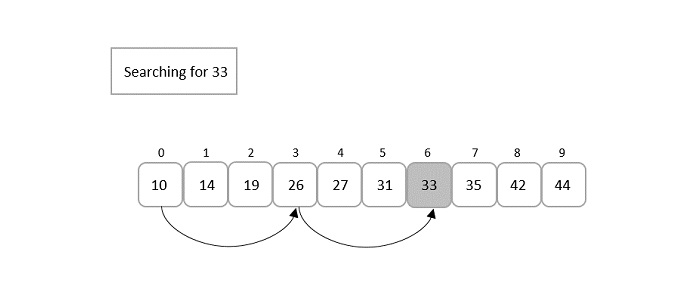Design and Analysis - Jump Search
Design and Analysis - Jump Search
Jump Search algorithm is a slightly modified version of the linear search algorithm. The main idea behind this algorithm is to reduce the time complexity by comparing lesser elements than the linear search algorithm. The input array is hence sorted and divided into blocks to perform searching while jumping through these blocks.
For example, let us look at the given example below; the sorted input array is searched in the blocks of 3 elements each. The desired key is found only after 2 comparisons rather than the 6 comparisons of the linear search.

Here, there arises a question about how to divide these blocks. To answer that, if the input array is of size ‘n’, the blocks are divided in the intervals of √n. First element of every block is compared with the key element until the key element’s value is less than the block element. Linear search is performed only on that previous block since the input is sorted. If the element is found, it is a successful search; otherwise, an unsuccessful search is returned.
Jump search algorithm is discussed in detail further into this chapter.
Jump Search Algorithm
The jump search algorithm takes a sorted array as an input which is divided into smaller blocks to make the search simpler. The algorithm is as follows −
Step 1 − If the size of the input array is ‘n’, then the size of the block is √n. Set i = 0.
Step 2 − The key to be searched is compared with the ith element of the array. If it is a match, the position of the element is returned; otherwise i is incremented with the block size.
Step 3 − The Step 2 is repeated until the ith element is greater than the key element.
Step 4 − Now, the element is figured to be in the previous block, since the input array is sorted. Therefore, linear search is applied on that block to find the element.
Step 5 − If the element is found, the position is returned. If the element is not found, unsuccessful search is prompted.
Pseudocode
Begin
blockSize := √size
start := 0
end := blockSize
while array[end] <= key AND end < size do
start := end
end := end + blockSize
if end > size – 1 then
end := size
done
for i := start to end -1 do
if array[i] = key then
return i
done
return invalid location
End
Analysis
The time complexity of the jump search technique is O(√n) and space complexity is O(1).
Example
Let us understand the jump search algorithm by searching for element 66 from the given sorted array, A, below −

Step 1
Initialize i = 0, and size of the input array ‘n’ = 12
Suppose, block size is represented as ‘m’. Then, m = √n = √12 = 3
Step 2
Compare A[0] with the key element and check whether it matches,
A[0] = 0 ≠ 66
Therefore, i is incremented by the block size = 3. Now the element compared with the key element is A[3].

Step 3
A[3] = 14 ≠ 66
Since it is not a match, i is again incremented by 3.

Step 4
A[6] = 48 ≠ 66
i is incremented by 3 again. A[9] is compared with the key element.

Step 5
A[9] = 88 ≠ 66
However, 88 is greater than 66, therefore linear search is applied on the current block.

Step 6
After applying linear search, the pointer increments from 6th index to 7th. Therefore, A[7] is compared with the key element.

We find that A[7] is the required element, hence the program returns 7th index as the output.
Implementation
The jump search algorithm is an extended variant of linear search. The algorithm divides the input array into multiple small blocks and performs the linear search on a single block that is assumed to contain the element. If the element is not found in the assumed blocked, it returns an unsuccessful search.
The output prints the position of the element in the array instead of its index. Indexing refers to the index numbers of the array that start from 0 while position is the place where the element is stored.
#include<stdio.h> #include<math.h> int jump_search(int[], int, int); int main(){ int i, n, key, index; int arr[12] = {0, 6, 12, 14, 19, 22, 48, 66, 79, 88, 104, 126}; n = 12; key = 66; index = jump_search(arr, n, key); if(index >= 0) printf("The element is found at position %d", index+1); else printf("Unsuccessful Search"); return 0; } int jump_search(int arr[], int n, int key){ int i, j, m, k; i = 0; m = sqrt(n); k = m; while(arr[m] <= key && m < n) { i = m; m += k; if(m > n - 1) return -1; } // linear search on the block for(j = i; j<m; j++) { if(arr[j] == key) return j; } return -1; }
Output
The element is found at position 8
Frequently Asked Questions
Recommended Posts:
- Design and Analysis of Algorithms Tutorial
- Design and Analysis Introduction
- Design and Analysis of Algorithm
- Design and Analysis Methodology
- Asymptotic Notations and Apriori Analysis
- Design and Analysis - Time Complexity
- Design and Analysis - Master’s Theorem
- Design and Analysis Space Complexities
- Design and Analysis - Divide and Conquer
- Design and Analysis Max-Min Problem
- Design and Analysis - Merge Sort
- Design and Analysis - Binary Search
- Design and Analysis - Karatsuba Algorithm
- Design and Analysis - Towers of Hanoi
- Design and Analysis - Greedy Method
